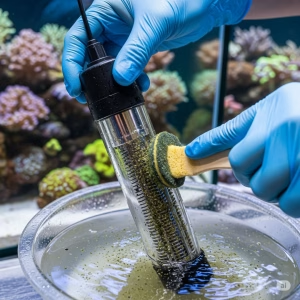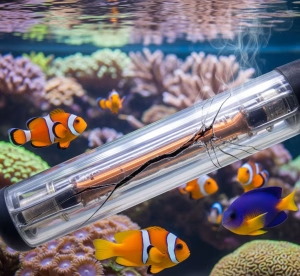Why Does So Much Water Evaporate in a Marine Aquarium - & Tips to Prevent Evaporation
Welcome to Simple Reefs. We are a brand new website designed to take the stress and expense out of starting your very own marine aquarium. We’ve been talking about Salinity a lot, lately. Today, we are talking about one of the most common causes for salinity swings – evaporation. Let’s answer the question of Why Does So Much Water Evaporate in a Marine Aquarium?
I should warn you now, especially if you are at the stage of deciding whether or not to purchase a marine aquarium. Evaporation is something you will be dealing with every single day. It is going to be one of those things that actually surprises you about the hobby. You will be constantly asking yourself “how the hell so much water keeps evaporating from my tank and where does it all go?“.
Note: Please keep in mind that Simple Reefs is a very new website. Some information may be incomplete, some links may not be active, and some articles may be unfinished. Please bear with us while we build.
The truth of the matter is, it is just one of the quirks of the hobby. The reasons for evaporation in your marine aquarium are quite simple; the solutions are equally as simple but preventing the problem is another story. Evaporation can cause a few very specific problems and one of them might impact more than just your tank. Let’s take a look.
Evaporation in a Marine Aquarium is Guaranteed
Believe it or not, evaporation is something a lot of beginner, or prospective, marine aquarium owners don’t give much consideration to. After all, when it comes to the long list of things that can go wrong with your brand new saltwater tank, evaporation seems like a minor issue.

The truth of the matter is, however, evaporation is a crisis waiting to happen. Unlike many of the potential problems that you encounter with your marine aquarium that you may never have to deal with. You are absolutely guaranteed to encounter evaporation and it will need to be dealt with in the correct manner.
Marine aquariums inherently lead to a couple of perfect scenarios for creating large levels of evaporation. Many of them are open topped to create that very familiar marine aquarium aesthetic and to allow maximum light into the water.
Many marine aquariums have sumps which are completely open and the vast majority are, also, heated to tropical water temperature levels like 24°C. Let’s not forget that we often have a lot more surface agitation in marine aquariums thanks to wavemakers and gyres, as well. Let’s take a closer look at those issues.
Why Are Marine Aquariums Prone to Evaporation?
Marine aquariums create a perfect storm for evaporation due to the factors outlined above but why is that?
Warm Water Evaporates Faster: The warm water contained within our tanks turns to vapor quicker than cold water due to the kinetic energy contained within the molecules. In other words, the molecules in warm water move around more which offers them an increased chance to break the water’s surface and transition into gas (evaporate).
Marine Aquarium Water Is More Agitated: Marine aquariums tend to feature more water agitation, particularly at the surface. We need flow in our aquariums for our strong swimming fish and for directing food to our coral. This water agitation, again, allows more water molecules to break the surface and escape.
We Don’t Cover Our Tanks: In a tank with a cover, much of this evaporation would hit the cover. This would cool the molecules and reduce the amount of movement in them, turning them back into water. This water is the exact same thing you would find on your windows on a cold morning – condensation. The water would then drip back into the tank and wouldn’t be lost.
Since many marine aquariums don’t have a cover, this evaporation is, instead, lost to the air. In fact, you are probably going to find it all over your windows and cold spots in the form of condensation in autumn and winter. That is unless you ventilate frequently and allow it to escape. I live in an old, cold, house so I have multiple forms of permanent ventilation to prevent this from happening.
Warm Lights Can Cause More Evaporation: Many high intensity lights that we use on our marine aquariums are designed to sit just over the surface of the water. This water is, already, typically agitated and freely moving. Our high intensity lights tend to give off a lot of heat. This heat further warms these water molecules on the surface that are already desperate to escape and gives them a helping hand. This causes even more evaporation.
So we can see that there are a good few reasons why evaporation can occur and why marine aquariums seem even more prone to it than freshwater. That leads us perfectly on to our next questions and this is the most important point of all.
Why Is Evaporation Dangerous to a Marine Aquarium?
Evaporation is dangerous to marine aquariums because evaporation changes the salinity of your water. Remember, when evaporation occurs, the only thing escaping the tank are H₂O molecules. Only water leaves, everything else is left behind. Dissolved calcium, dissolved magnesium, and, most importantly of all, dissolved salt.

In a freshwater tank, when water evaporates, the only things left behind are concentrated minerals. In a marine aquarium, when the water evaporates, the dissolved salts are left behind. This, in essence, increases the concentration of salts in your aquarium’s water. The same amount of salt in a smaller body of water equals a higher concentration of salt, thus increased levels of salinity.
As we have talked about in our article on Refractometers and The Importance of Measuring Salinity, maintaining stable salinity levels is incredibly important to the health of your aquarium. The creatures in your aquarium are adapted to living in saltwater but they are highly sensitive to fluctuations of salinity but why is this?
Osmoregulation – A Careful Balancing Act
Every animal in your tank is constantly maintaining a careful balance between the salt in their cells and the salt in their environment. This process is known as osmoregulation. When salinity levels in your aquarium are within the desired range (click here for more information on what your marine aquarium’s salinity should be), this process is not a problem. After all, these creatures have evolved and adapted to survive in saltwater.
When your salinity levels are incorrect or when they swing rapidly, however, this process becomes a lot more difficult. The creature’s organs will have to work harder to maintain this delicate balance. This will result in their metabolism increasing, as a result. This can lead to stress, illness, and even death.

Fish can experience something known as osmotic shock. Water can rush into, or out of, their cells which can cause long term damage to the cell’s structure and cause lasting problems for the fish itself. Coral can bleach due to the expulsion of their symbiotic algae (zooxanthellae) and invertebrates can experience issues with lethargy and stress. Some may even struggle to moult sufficiently.
We have talked a lot about the causes of salinity swings in a marine aquarium in this article here. We also offer up a few ways to deal with salinity swings so go check that article out if you want a head start.
Suffice to say, evaporation causing an increase in salinity can be a disaster for your marine aquarium. The evaporation can even begin to cause problems with your health and your home as we are going to discuss in an upcoming article. But what can we do to prevent this evaporation?
Check Your Salinity & Tips for Preventing Evaporation
Before we get onto some tips for prevention of evaporation, we need to emphasise the importance of staying on top of your aquarium’s salinity level. It is imperative that you frequently check your aquarium’s salinity. In fact, it is one of the most important water parameters to test.
I suggest making it a once a week part of your testing routine in this article here. I also show you how to test your aquarium’s salinity in this article on Refractometers. A refractometer is cheap, easy to use, and accurate. Test your salinity frequently.
There are a few things that we can do to help prevent evaporation. Some of these tips and tricks work pretty well but even with best practices we will still encounter the issue frequently. Let’s take a look.
Location is Key: If you have your aquarium in a room that is warmer than the water in your tank, you will experience more evaporation. Likewise, if you have a tank with lots of surface agitation, the same thing will happen. Reduce surface agitation with caution, after all, this may be the only thing oxygenating your water. Choosing a cooler location may be impractical.
Cover Your Tank: This is another option but you have to give some serious consideration to covering your tank. Covers will definitely reduce evaporation. In fact, I cover mine to keep heat in during the winter to reduce energy costs and the difference is dramatic.

In the summer, however, I switch to a mesh cover. The reason for this is that most of the heat loss in an aquarium is through evaporation. During the summer, particularly in a warm house, this can quickly lead to overheating. It can also cause problems with gas exchange which can increase CO2.
A mesh cover is a nice middle ground that looks good, doesn’t block too much light, and allows heat and gases to escape. Mesh covers won’t make a dramatic difference to your levels of evaporation but it will definitely help.
Watch Your Temperature: Warm water evaporates faster due to the increased kinetic energy in the water molecules. More kinetic energy means more movement and more chances to break the water’s surface and escape in the form of vapour. If you have a very warm marine aquarium, consider dropping it a degree or so. You may notice a bit of a difference.
Raise Your Lights: If you are using very warm, high intensity, lights, you may find they are part of the problem. A warm light will heat the water on the surface and cause it to evaporate faster. Consider lifting your lights away from the water’s surface a few inches to lower the amount of heat reaching the water.
Try to Minimise Splashing: Equipment that kicks water up into the air in a fine mist will lead to more evaporation. If you have a gyre or wavemaker that is spraying a very fine mist of water out of the surface, you might want to lower it just a bit. This should help more than you might realise.
In Short
Evaporation in a marine aquarium is just a fact of life. It is a guaranteed part of the experience. Monitoring your salinity levels should be a weekly task and topping up evaporation should be done frequently as detailed in this upcoming guide right here. There are ways to reduce the amount of evaporation such as covers and reducing heat. Staying on top of the levels of evaporation are the most important thing, however, to keep your fish and coral healthy. Thanks for reading and spending your time at Simple Reefs.








